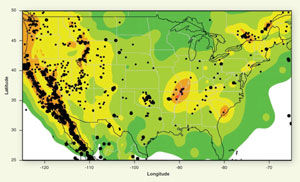At least one aspect of the natural gas fracking process is improving – its massive use of water.
The industry’s water addiction is literally draining municipal water supplies and water needed for farms because a single fracking well consumes up to 5 million gallons of water.
But the practice of using recycled water instead is gaining acceptance. After all, they’re injected a brew of toxic chemicals into the water anyway, so why would it need to be pure?
It also cuts costs. In Texas, for example, where water is extremely scarce, companies have to haul it in and then haul the wastewater to disposal wells. Recycling eliminates all that transportation – one of the biggest costs – because water is treated on site and then reused again.
About 90% of the water used to drill in the Marcellus shale is recycled because the geology doesn’t suit wastewater disposal wells.
"It is a paradigm shift," Walter Dale from Halliburton told Reuters. Until recently, he says, companies considered recycling too expensive or worried that using anything other than freshwater would reduce well output. Some still believe using underground water requires less chemicals, however.
Meanwhile, the EPA has approved chemical-laced wastewater as fine to drink for wildlife and livestock. The agency is giving permits for wastewater to be dumped into surface water, ignoring its own regulations, says Public Employees for Environmental Responsibility (PEER).
Dumping it into streams is forbidden in the Eastern US, but it’s allowed in the arid West for purposes of "agricultural or wildlife propagation."
Although fracking chemicals remain trade secrets, a recent analysis identifies 632 chemicals used. Over 75% affect respiratory and gastrointestinal systems; 40-50% impact kidneys and nervous, immune and cardiovascular systems; 37% act on the hormone system; and 25% are linked with cancer or mutations, reports PEER.
Legislation in EU, US
In the US, the FRAC Act has been re-introduced in both houses, which would regulate the natural gas industry under the Safe Drinking Water Act. Unlike every other industry, oil and natural gas drillers are exempt from those regulations because of the "Halliburton Loophole" installed by former vice president Cheney.
This week, the European Parliament’s Environment Committee overwhelmingly voted to mandate Environmental Impact Assessments before any fracking takes place to provide baseline data and allow communities to engage early on.
Earthquake Connection
Since fracking began in earnest, places that usually don’t have earthquakes have been experiencing them near drilling sites in Oklahoma, Arkansas, Ohio, Texas and Colorado. The US Geological Survey has connected this increase in earthquake activity with the fracking process.
Earthquakes from 2009-2012, small dots indicate small earthquakes, larger dots indicate bigger ones.

Now, seismologists at Columbia University have found that major, faraway earthquakes are triggering them in the Central US near drilling sites.
Furthermore, say researchers, "such triggering of minor quakes by distant events could be precursors to larger events at sites where pressure from waste injection has pushed faults close to failure."
"The fluids (in wastewater injection wells) are driving the faults to their tipping point," says Nicholas van der Elst of Columbia’s Lamont-Doherty Earth Observatory. "The remote triggering by big earthquakes is an indication the area is critically stressed."
Scientists have long been aware that earthquakes can be triggered from far away, but this study, published in Science is the first to link this phenomenon to faults that have been weakened by human activity.
So far the largest fracking-induced earthquake was a magnitude 3.6 – too small to pose a serious risk – but injection wells can set the stage for more dangerous quakes, say the researchers. "Because pressure from wastewater wells stresses nearby faults, if seismic waves speeding across Earth’s surface hit the fault it can rupture and, months later, produce an earthquake stronger than magnitude 5," van der Elst explains to Reuters.
"What seems to happen is that wastewater injection leaves local faults ‘critically loaded,’ or on the verge of rupture. Even weak seismic waves from faraway quakes are therefore enough to set off a swarm of small quakes in a process called ‘dynamic triggering.’"
For example, Japan’s 9.1 magnitude earthquake which resulted in a tsunami, triggered a swarm of small quakes at a Texas oil field and six months later, there was a 4.5 magnitude quake.
Read more about this study:
